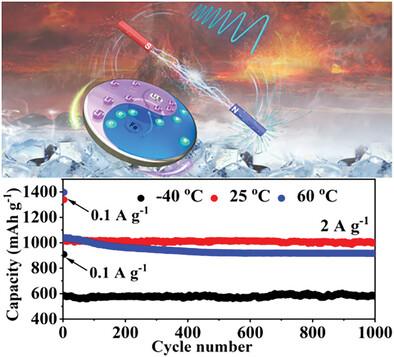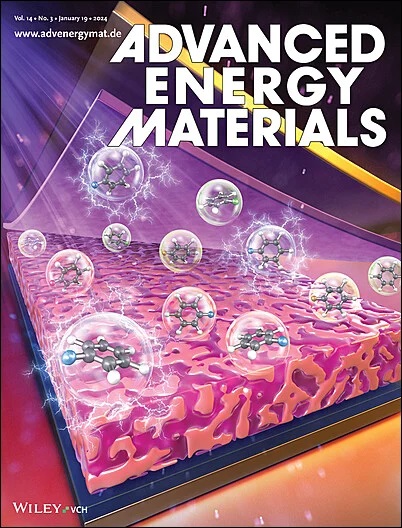Hollow Microsphere Structure and Spin‐Polarized Surface Capacitance Endow Ultrafine Fe7S8 Nanocrystals with Excellent Fast‐Charging Capability in Wide‐Temperature‐Range Lithium‐Ion Batteries
IF 24.4
1区 材料科学
Q1 CHEMISTRY, PHYSICAL
引用次数: 0
Abstract
Fe

中空微球结构和自旋极化表面电容赋予超细 Fe7S8 纳米晶体在宽温范围锂离子电池中卓越的快速充电能力
Fe7S8 作为一种转换型负极,在锂离子电池(LIB)中显示出很高的容量。然而,离子传输速率低、电子传导性能差以及循环时体积变化大等缺点限制了它在快速充电宽温差锂离子电池中的应用。本文提出了一种简单的水热法和随后的固相高压硫化路线来合成中空的 Fe7S8/N 掺杂 C 微球结构。中空空间被嵌入掺杂 N 的 C 基体中的超细 Fe7S8 纳米晶体(≈8 nm)组成的球壳所包围,从而增强了离子传输和电传导,并适应了 Fe7S8 的体积膨胀。值得注意的是,原位磁力测定法显示,在转化反应阶段会产生自旋极化表面电容,其中形成的 Fe 和 Li2S 分别作为电子和离子的受体,在它们的界面上构建空间电荷区,从而增强锂的传输和存储。因此,空心微球在 -40 至 60 ° C 的 Ah 级袋式电池中显示出较高的重力能量密度和出色的快速充电能力,以及卓越的循环稳定性。这项研究首次证实了自旋极化表面电容效应在快速充电宽温范围锂离子电池中增强离子存储和传输的有效性。
本文章由计算机程序翻译,如有差异,请以英文原文为准。
求助全文
约1分钟内获得全文
求助全文
来源期刊

Advanced Energy Materials
CHEMISTRY, PHYSICAL-ENERGY & FUELS
CiteScore
41.90
自引率
4.00%
发文量
889
审稿时长
1.4 months
期刊介绍:
Established in 2011, Advanced Energy Materials is an international, interdisciplinary, English-language journal that focuses on materials used in energy harvesting, conversion, and storage. It is regarded as a top-quality journal alongside Advanced Materials, Advanced Functional Materials, and Small.
With a 2022 Impact Factor of 27.8, Advanced Energy Materials is considered a prime source for the best energy-related research. The journal covers a wide range of topics in energy-related research, including organic and inorganic photovoltaics, batteries and supercapacitors, fuel cells, hydrogen generation and storage, thermoelectrics, water splitting and photocatalysis, solar fuels and thermosolar power, magnetocalorics, and piezoelectronics.
The readership of Advanced Energy Materials includes materials scientists, chemists, physicists, and engineers in both academia and industry. The journal is indexed in various databases and collections, such as Advanced Technologies & Aerospace Database, FIZ Karlsruhe, INSPEC (IET), Science Citation Index Expanded, Technology Collection, and Web of Science, among others.
 求助内容:
求助内容: 应助结果提醒方式:
应助结果提醒方式:


